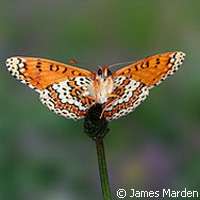Understanding mechanisms that are fundamental to changes in life history traits is crucial for our understanding of adaption by natural selection. While research in this field has improved, functional genomics studies of life history adaptations have only started to get off the ground. A team of scientists from Finland and the US are helping drive this research. They have found that descendants of 'exploratory' butterflies that colonised new habitats are genetically different from their cousins that prefer to stay put.
Funded by the European Research Council (ERC), the study is presented in the journal Molecular Ecology.
The research team includes Professor Ilkka Hanski from University of Helsinki in Finland, and Professor James Marden and Dr Christopher Wheat of Pennsylvania State (Penn State) in the US.
They discovered genetic bases for faster egg maturation, greater flight ability and increased energy metabolism in descendants of exploratory butterflies. These traits gave these wandering butterflies an advantage. According to the scientists, the findings could lead to a better understanding of how natural selection may act in species that occupy spatially distinct habitat patches.
Professor Ilkka Hanski investigated Glanville fritillary butterflies from the Åland Islands of Finland by using novel gene-sequencing technology to characterise thousands of protein-coding genes. Professor Hanski's work on butterflies has clinched him this year's Craaford Prize, what experts consider ecology's version of a Nobel prize.
'The Glanville fritillary project in Finland was started in 1991 and it has played an important role in the development of metapopulation biology,' Professor Hanski comments. 'The butterfly inhabits a large network of 4 000 small meadows. There are no large populations, and the landscape-level persistence is hence based on a balance between stochastic local extinctions and recolonisation of currently unoccupied meadows. A series of studies has demonstrated that females that establish new local populations are more dispersive than the average female in the metapopulation, and there are also other life-history differences between butterflies in newly-established versus old populations,' he adds.
For his part, Professor Marden says: 'Butterflies, like many other species, are specialists. They are picky about where they live. This pickiness gives a species what ecologists call a clumped or patchy distribution. In a patchy environment, individual organisms face a fundamental choice between remaining in their native patch or venturing forth to find a different patch of suitable habitat. Staying put is safer for immediate survival but may expose one's offspring to crowding our parasites, whereas dispersal is dangerous but offers a potentially big payoff if a large, unoccupied patch is located.
'We wanted to understand better the genes and physiology involved in determining sedentary, "stay-at-home" traits versus exploratory, "venture-forth" traits,' Professor Marden adds. 'Evolutionary biologists are fascinated by cost-benefit questions such as how natural selection produces and maintains both "stay-at-home" and "venture-forth" varieties within species.'
According to the experts, the 'stay-at-home versus venture-forth' dichotomy plays a crucial role in ecology because changes in habitat, as well as chance events and disease, trigger the local extinction of small populations in individual patches.
'Species persistence on a regional scale requires that the rate of establishment of new populations must be at least as high as the rate of local-population extinctions,' Professor Marden says. 'Dispersal of individual females is what determines the establishment rate, along with the number of patches and distances between them.'
The Marden and Hanski labs measured and compared the variation in gene-expression levels in females from established butterfly populations (i.e. old, local populations that persisted for no less than five years) with new, local populations that were established by exploratory butterflies.
A significant difference was seen in the old- and new-population butterflies, specifically in how they expressed certain genes that control the timing and release of stored proteins for egg production as well as the maintenance of flight-muscle proteins. The team discovered variations of the butterflies' flight metabolic rate (measure of muscle performance and flight ability).
The team also found that another gene variant played a key role in butterfly flight ability: phosphoglucose isomerase (Pgi). They also discovered that a tiny part of the succinate dehydrogenase gene (Sdhd) is not found in new-population females.
'The Pgi gene variant seems to be associated with sprinting, and the Sdhd gene variant appears to be associated with endurance,' Professor Marden says. 'It's easy to see why these traits and their associated genes would be found at higher frequencies in new populations. Better flight ability allows certain butterflies to be able to reach and settle new habitat patches.'
Commenting on the findings, Professor Hanski says: 'The new study demonstrates significant differences in gene expression between new versus old populations. Many of these genes have functions that are related to the physiological and life-history traits that have been shown to exhibit differences between the population types, thus suggesting hypotheses about the genetic basis of life-history variation among populations. My group in Helsinki is currently sequencing the full genome of the Glanville fritillary and we are developing association and linkage analyses with very extensive material on phenotypic variation across the entire study system.'
More information: Wheat, C.W., et al. (2011) Functional genomics of life history variation in a butterfly metapopulation. Molecular Ecology, published online 17 March. DOI:10.1111/j.1365-294X.2011.05062.x
Provided by CORDIS





















